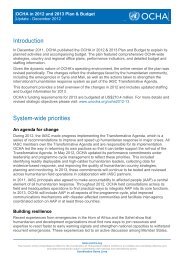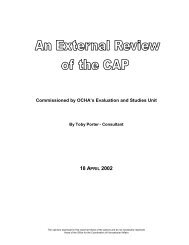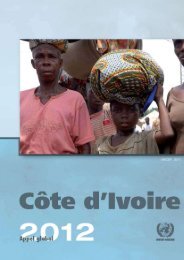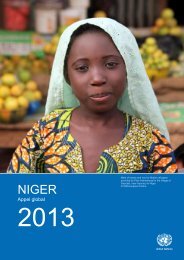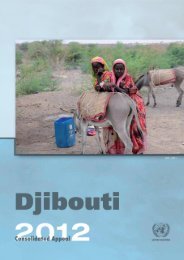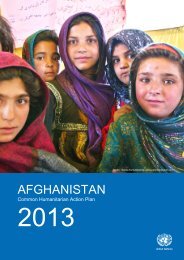SUDAN
Sudan: UN and Partners Work Plan 2012 - ReliefWeb
Sudan: UN and Partners Work Plan 2012 - ReliefWeb
- No tags were found...
You also want an ePaper? Increase the reach of your titles
YUMPU automatically turns print PDFs into web optimized ePapers that Google loves.
60[3] Sector Response plans United Nations and Partners<strong>SUDAN</strong> WORK PLAN 2012Overview of sector objectives (Health)ObjectivesTo contributetowards betteraccess for vulnerablepopulationsto quality primaryand secondaryhealth careservices.To strengthenlocal capacity topredict, preparefor, respond to,mitigate andmanage healthrisks that includecommunicablediseases andseasonal emergencies.To contributeto a reductionin maternal andchild morbidityand mortalityfocusing on safemotherhood andchild survivalinterventionsOutcomes withcorresp. targets• Individuals andcommunities, withspecial emphasis onvulnerable and at-riskpopulations, haveincreased access toquality primary andsecondary health careservices• Reduced mortalityand morbidity relatedto communicabledisease outbreak.• By the end of 2012,all communicabledisease outbreaksare detected andresponses are initiatedwith 72 hours.• Reduced maternaland child mortalityand morbidity• By the end of 2012the Health Sectorhas enhanced safemotherhood and childsurvival initiatives thusreducing maternal andchild morbidity andmortalityOutputs with corresp. targets• Increased PHC facilities that provide minimum basic PHCpackage (Immunization, ANC, treatment of common diseases)of services.• Increased availability of trained health personnel and communityhealth workers in disadvantaged states.• Essential medicine, medical supplies, guidelines, and healtheducation material to are provided to targeted health facilities.• Comprehensive health management information systems,established at all levels.• Essential structure and functional capacities of prioritizedhealth facilities rehabilitated.• Mental health counselling & care at health facilities in conflictand post conflict areas increased• Improved coordination, partnership, predictability andresponsibility amongst all actors.• Strengthened systems for integrated disease surveillance ofcommunicable diseases and EWARS.• Essential reagents, rapid test kits, equipments, and diagnostictools to health facilities are provided.• Capacities for disaster management and communicabledisease control and prevention in complex emergenciesStrengthened.• Improved vector control campaigns , reduced incidence ofVector borne diseases• Improved water quality reduced incidence of Water borndiseases.• Strengthened outbreak emergency preparedness andresponse capacity and early detection• Improved access to maternal services with focus on reproductivehealth services (ANC, PMTCT, PNC, PAC, family planningand emergency management of obstetric care (EMOC),• Improved prevention and management of STIs/HIV/AIDScases, including victims of sexual violence (SGBV)• Increased utilization and access of mothers and childrenunder five years to essential curative health care services• Enhanced accelerated Child Survival Initiative interventions(including EPI, IMCI, IYCF, and school health)• Increased immunization coverage for women and childrenunder five.Indicators with corresp. targets and baselineIndicators• % Health facilities providing minimum basicpackage of primary health services (treatmentof common disease, immunization and ANC).• % of population covered by functioning healthfacility (Key health providers/facility, accordingto the definition of FMOH for type of healthunit/serving population).Corresponding targets• 80% of primary health care facilities will providebasic health packages. (baseline: 63 percent).• 80% of population covered by functioninghealth facilities (baseline: 78 percent)..Indicators• Percentage of communicable disease outbreaksdetected and responded to within 72 hours• Percentage of states with emergency preparednessand response plans.Corresponding targets• Maintain 100 percent of outbreaks reported andresponded to. (baseline: 100 percent).• Ten percent of states have emergency preparednessand response plans. (baseline: six states).Indicators• Percentage of HF providing basic EMOC• Percentage of births attended by skilled birthattendants• Coverage of Penta 3 vaccine in children belowone year of age/state.• Percentage of HF providing IMCI services.Corresponding Targets• 60 percent of health facilities providing basicEMOC/per locality/state• 80 percent of births attended by skilled birthattendants.• 60 percent of health facilities providing IMCIservices (baseline is 52 percent).• 95 percent of PENTA 3 coverage immunization.• Promote the Accelerated Child Survival Initiative interventionsincluding coverage of immunization, integratedmanagement of childhood illness (IMCI), and school health.In addition, sustainable approaches and durable solutionsthat will reduce aid dependence among the people aremainstreamed into the sector priorities. The focus will be onmaintaining primary and secondary health care services to thedisplaced and other vulnerable populations, with a specialfocus on women and children below five years of age, in additionto identifying and covering gaps in health services inunderserved or inaccessible areas.such visits will be shared with partners through regular/ad hocsector meetings or bulletins to ensure a coordinated responseto emerging needs. Meanwhile, the Health Resources AvailabilitySystem (HeRAMs) reports are also shared on quarterlybasis, aiming to provide updates on the provision of healthservices in Darfur. The HeRAMS is also rolling out in SouthKordofan State.Sector monitoring planThe Health Sector will compile reports from health partners ona quarterly basis in an effort to measure progress, achievementsand constraints against stated targets. The Health Sector willvisit all projects/locations on a regular basis. The findings of




